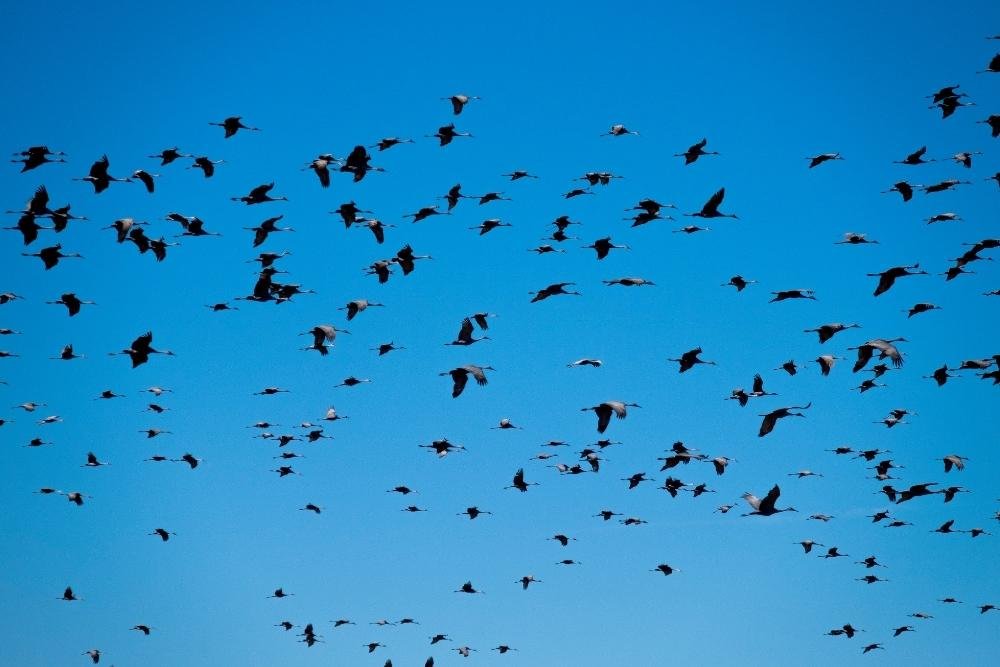Sandhill Cranes
Aldo Leopold, the father of modern day wildlife management, wrote about the Sandhill Cranes, saying “When we hear his call, we hear no mere bird. We hear the trumpet in the orchestra of evolution.” The fossils of a bird with identical structure to the Sandhill Crane has been carbon dated to have lived 10 million years ago, making the Sandhill Crane the longest surviving bird on the planet.
“When we hear his call, we hear no mere bird. We hear the trumpet in the orchestra of evolution.”
Standing at over 4 feet tall and having a wing span of over 6 feet, the Sandhill Crane is one of the largest birds found in the Eastern United States. They are gray in color with a long neck, long legs and a long pointed beak used for probing in the soil for seeds and insects. The Sandhill Cranes also have a distinctive red patch on their forehead, which is larger on the males. During breeding season, the cranes will increase the blood flow to this area on the forehead, creating a bright red color to attract their potential mates. They usually live in areas with large open fields and shallow water. Their primary food sources are seeds, insects, and benthic macroinvertebrates.
Every year, these magnificent birds migrate from the Prairie Pothole region of the upper midwest and southern Canada down to the gulf coast. While in flight, the Sandhill Cranes call constantly. These calls can be heard from over a mile away and help the cranes keep their flight pattern. They typically fly in a V formation and can be easily distinguished from Geese by the long legs trailing behind them. Starting in 1990, the Tennessee Wildlife Resource Agency (TWRA) began a program to make Eastern Tennessee a stopover location for these migratory birds. One of the locations chosen was the Hiwassee Wildlife Refuge in Birchwood, Tennessee. Here, a flock of some 80,000 Sandhill Cranes will stop to rest and feed during their migration South. TWRA plants this area every year in corn to supply some of the food needs, and, with shallow water nearby, this creates an ideal location for the Cranes to rest.
Whooping Cranes
Mixed within these large flocks of Sandhill Cranes there exists one of the most highly endangered birds in the United States. The beautiful and majestic Whooping Crane is learning to migrate with the Sandhill Cranes. There are only about 450 Whooping Cranes in the wild and about 160 in captivity. These birds are slightly larger than the Sandhill Cranes and have bright white plumage. When they started the recovery program in the 1940s, there were only 21 Whooping Cranes left alive due to habitat loss and hunting. The Whooping Cranes were taken into captivity and bred. Since there were no wild Whooping Cranes left, when they were released, they didn’t know how or where to migrate. Scientists used an ultralight to guide the cranes during the migration and made the trip with the natural migration of the Sandhill Cranes. These birds have since learned to migrate with the Sandhill Crane flocks.
An Afternoon With the Cranes
Want to learn more about these amazing birds? Reflection Riding Arboretum & Nature Center, in partnership with Tennessee Ornithological Society (TOS), will host a day of learning about the Sandhill Cranes on January 29, 2022. We will start the day with Dr. David Aborn. Dr. Aborn is the Ornithology professor at the University of Tennessee at Chattanooga and has been involved with Sandhill Crane research at the Hiwassee Refuge for years. Starting at noon, he will give a brief history and discussion about the Sandhill Crane population that migrates through Tennessee. We will also provide an opportunity to view our captive Sandhill Cranes up close. At around 1:30pm, we will caravan out to the Hiwassee Refuge. Members of the TOS will meet us at the observation platform. They will provide the use of their spotting scopes and be available to answer questions about the Sandhill Cranes. This will be a wonderful opportunity to learn about and enjoy these magnificent birds.
Sign up for the event to learn more about Sandhill Cranes.
- By Corey Hagen, Director of Education
Corey is a lifelong outdoor enthusiast whose passion is introducing and teaching children about the natural world around them. In 2005, Corey joined the team working in education and marketing. In 2011, Corey became the Director of Education for Reflection Riding Arboretum and Nature Center and has been growing programming, outreach, and educational opportunities for the community ever since. Corey’s love of the natural world and desire to educate the next generation has placed him in a perfect work environment in a place that is very dear to his heart. During his time away from work, Corey enjoys taking hikes with his family and introducing his two children to the natural world.


